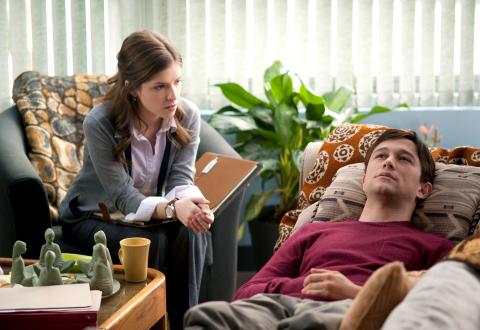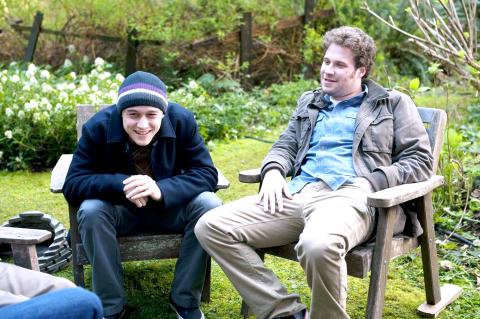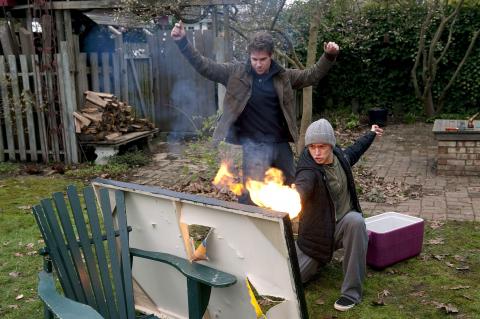50/50, a feel-good and slightly bad comedy-drama about a young man’s fight against cancer, aims to put a tear in your eye and a sob in your throat, if not for long. Certainly the waterworks don’t need much plumbing, as might be expected when the 27-year-old Adam (Joseph Gordon-Levitt), a Seattle radio producer, learns that he has a malignant spinal tumor. Shock and grief and bewilderment ensue as do jokes about barbered testicles and the wisdom of playing the C (as in cancer) card with chicks.
The wisenheimer coaxing those light laughs is Adam’s best friend, Kyle, played and sometimes bellowed by a shaggy Seth Rogen with his familiar mix of affability, innocence and vulgarity. As with most of Rogen’s characters, Kyle is really only guilty of coarse manners and of being a puppyish hound, which in the bromance world is a natural state of grace, close to a benediction. Like all bromance dudes, Kyle is the kind of decent guy that every other decent guy wants to have at his side, especially if the woman occupying that spot is as uptight as Adam’s girlfriend, Rachael (Bryce Dallas Howard). She paints abstract canvases and isn’t sexually giving, so you can guess where that’s headed.
Most of the rest of the signposts are as obviously planted. Directed by Jonathan Levine (The Wackness), 50/50 was written by Will Reiser, who based it on his own experiences with spinal cancer. (He and Rogen became friends while working on the satiric television series Da Ali G Show. Reiser no longer has cancer.) When the story opens, Adam is settling into domesticity with Rachael (he’s cleared out a drawer for her in his apartment) and together with Kyle is working at a public radio station. The two men do toil — you see Adam briefly laboring over a story about a volcano — but their jobs mostly register as afterthoughts, narrative rationales for their cars and homes.

Photo courtesy of Catchplay
A persistent pain in his back sends Adam to the doctor where he soon receives his grim diagnosis, his disbelief no match for the coolly delivered, frightening-sounding medical terms that rush over him like darkness. Within seconds he has crossed into the land of the sick, a place that the filmmakers try to portray with real, difficult feeling while also making it as cozy and finally unthreatening as possible. It’s a tough balancing act, one that Levine and Reiser struggle with as they — along with Kyle’s crude cutup and Adam’s tragic figure — keep toggling between the film’s genuinely funny bits and those interludes that grope toward scarier, heavier. Then Anna Kendrick , as Katherine, a 24-year-old therapist assigned to Adam, shows up and makes everything better.
The likable Gordon-Levitt has a thousand ways to look unhappy, dejected, depressed, freaked out, wrung out and sick to his stomach, but there’s something so recessive about Adam, or rather underconceived, that the character never grabs you as hard as you expect and really need. The problem isn’t that he needs to win you over: the diagnosis and Gordon-Levitt’s natural appeal put you on Adam’s side readily enough. It’s that neither the actor nor the filmmakers can get under Adam’s skin, despite all the close-ups and the moodily shot scenes filled with the kind of movie silence that feels more like the groping of an uncertain screenwriter than of a man facing his mortality.
That said, Gordon-Levitt keeps your sympathies, even when Adam enters wincing-relationship terrain with Rachael. (Howard improves with each performance but should be careful not to lock herself into shrewish type.) Rachael’s behavior doesn’t ring true, but unlike in some bromances, neither is she just another stick figure with breasts, and Howard makes a real character out of her. Other dividends include a very nice Anjelica Huston as Adam’s mother, the great Philip Baker Hall as a cancer-afflicted curmudgeon self-medicating with weed and, best of all, Kendrick (familiar as George Clooney’s foil in Up in the Air), an actress whose superb comic timing lifts the movie, and you.

Photo courtesy of Catchplay

Photo courtesy of Catchplay

May 26 to June 1 When the Qing Dynasty first took control over many parts of Taiwan in 1684, it roughly continued the Kingdom of Tungning’s administrative borders (see below), setting up one prefecture and three counties. The actual area of control covered today’s Chiayi, Tainan and Kaohsiung. The administrative center was in Taiwan Prefecture, in today’s Tainan. But as Han settlement expanded and due to rebellions and other international incidents, the administrative units became more complex. By the time Taiwan became a province of the Qing in 1887, there were three prefectures, eleven counties, three subprefectures and one directly-administered prefecture, with

President William Lai (賴清德) yesterday delivered an address marking the first anniversary of his presidency. In the speech, Lai affirmed Taiwan’s global role in technology, trade and security. He announced economic and national security initiatives, and emphasized democratic values and cross-party cooperation. The following is the full text of his speech: Yesterday, outside of Beida Elementary School in New Taipei City’s Sanxia District (三峽), there was a major traffic accident that, sadly, claimed several lives and resulted in multiple injuries. The Executive Yuan immediately formed a task force, and last night I personally visited the victims in hospital. Central government agencies and the

Among Thailand’s Chinese Nationalist Party (KMT) villages, a certain rivalry exists between Arunothai, the largest of these villages, and Mae Salong, which is currently the most prosperous. Historically, the rivalry stems from a split in KMT military factions in the early 1960s, which divided command and opium territories after Chiang Kai-shek (蔣介石) cut off open support in 1961 due to international pressure (see part two, “The KMT opium lords of the Golden Triangle,” on May 20). But today this rivalry manifests as a different kind of split, with Arunothai leading a pro-China faction and Mae Salong staunchly aligned to Taiwan.

As with most of northern Thailand’s Chinese Nationalist Party (KMT) settlements, the village of Arunothai was only given a Thai name once the Thai government began in the 1970s to assert control over the border region and initiate a decades-long process of political integration. The village’s original name, bestowed by its Yunnanese founders when they first settled the valley in the late 1960s, was a Chinese name, Dagudi (大谷地), which literally translates as “a place for threshing rice.” At that time, these village founders did not know how permanent their settlement would be. Most of Arunothai’s first generation were soldiers